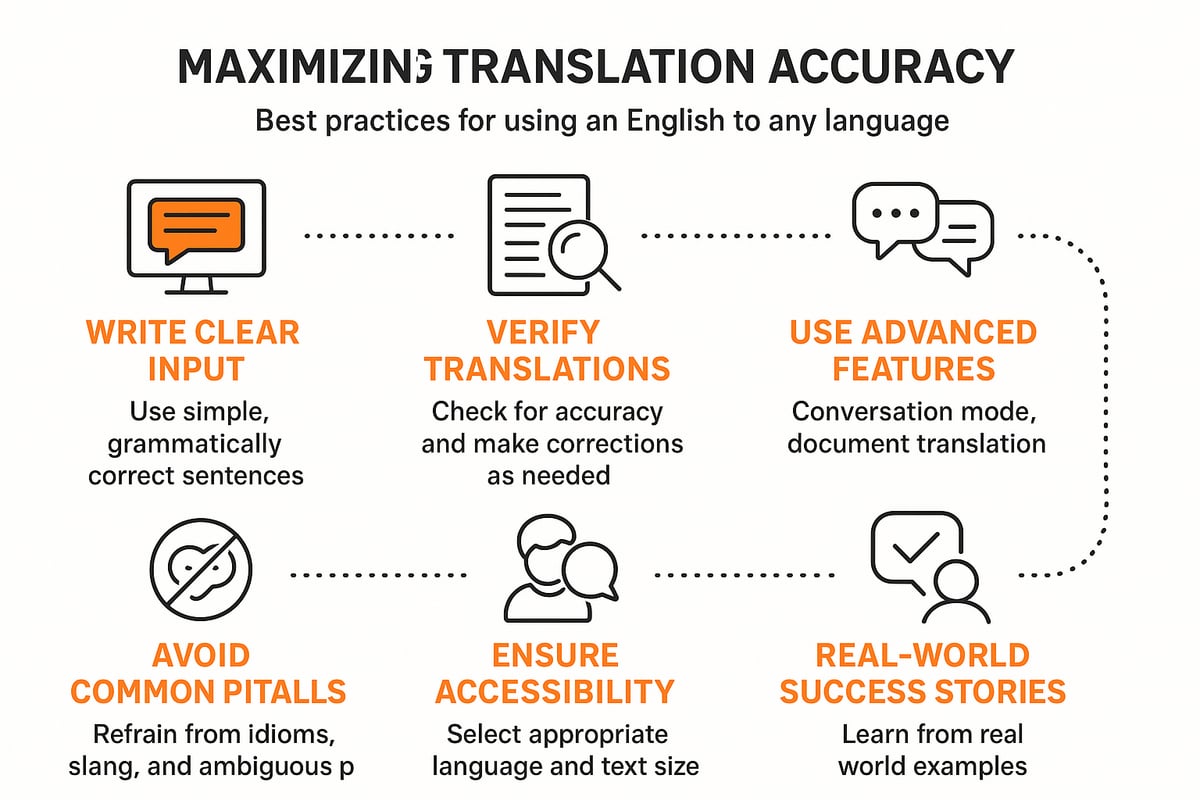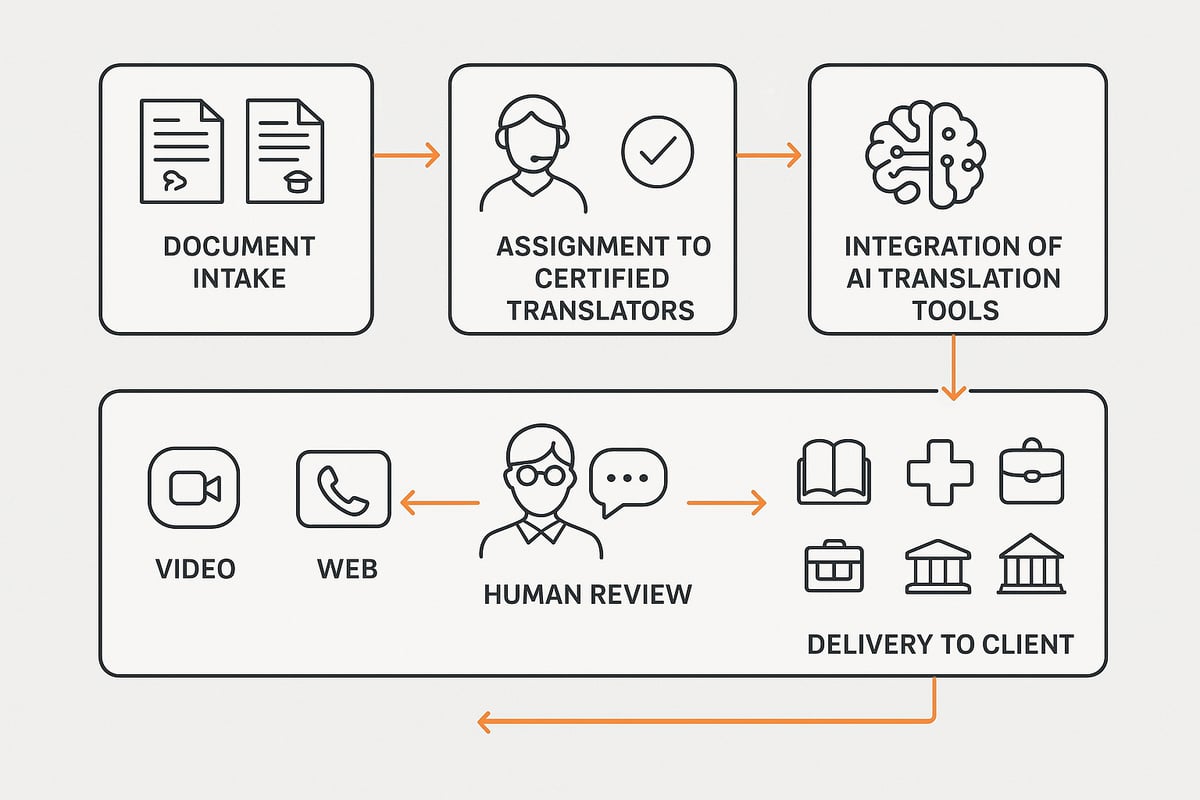In 2025, online English translation tools have reached new heights, offering instant access to...
AI Audio Translator Guide: Seamless Voice Translation 2025
Imagine being able to speak any language and have your words understood instantly, no matter where you are. In 2025, the ai audio translator is making this possible, transforming global communication for everyone.
This guide will show you how these tools work, what features matter, and how they are used across industries. You will discover the top platforms, step-by-step setup instructions, and what future trends to watch.
Prepare to unlock seamless voice translation and make the world more accessible, practical, and connected.
Understanding AI Audio Translation Technology
The rise of the ai audio translator in 2025 marks a turning point in global communication. This technology allows people to converse across languages effortlessly, removing barriers in real-time. But how does it work, what advancements drive its precision, and where do its limitations lie?
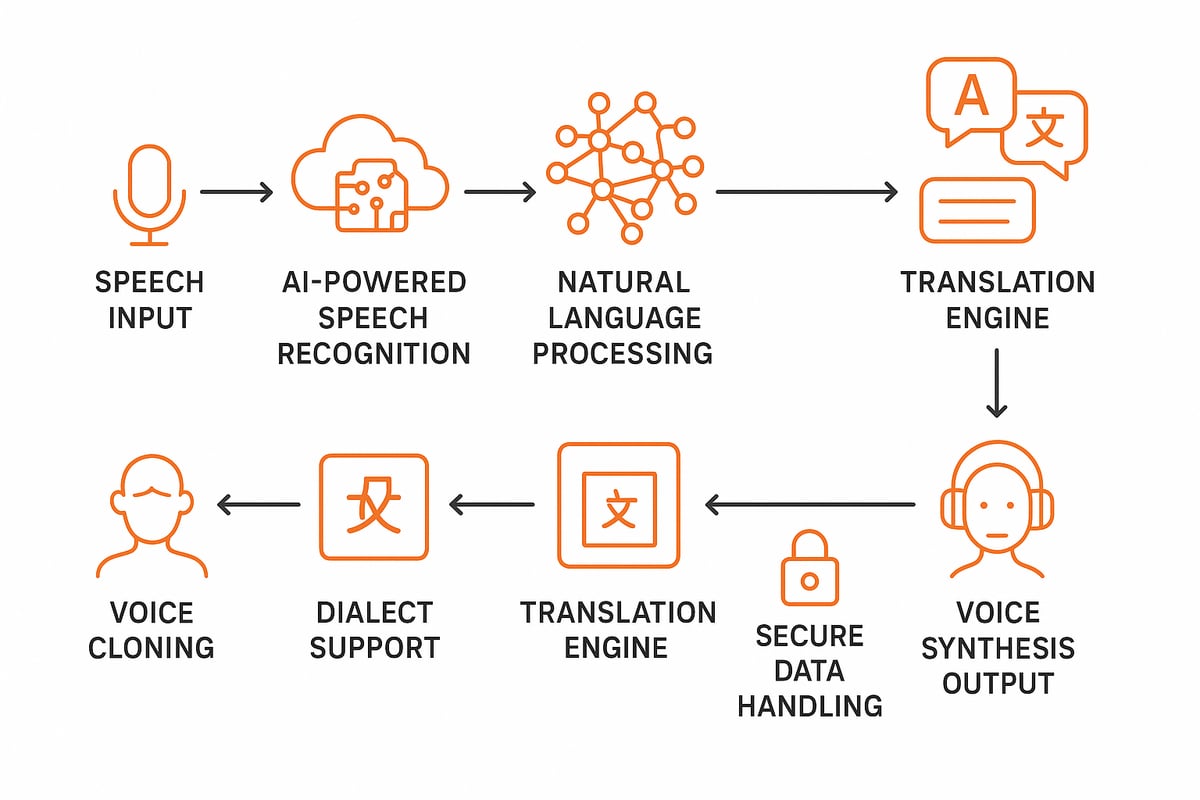
How AI Audio Translators Work
At the core of any ai audio translator is a sophisticated pipeline. The process starts with speech recognition, where the tool converts spoken language into text using advanced AI models. This step relies heavily on deep learning algorithms trained on vast datasets.
Once the speech is transcribed, natural language processing (NLP) engines take over. Here, the text moves through translation engines that interpret it into the target language. The next phase is text-to-speech synthesis, where the translated text becomes spoken output.
Neural networks and deep learning play a crucial role in refining accuracy. These models are trained on millions of voice samples and language pairs to recognize accents, dialects, and speech patterns. The more diverse the training data, the better the ai audio translator performs.
There are two main approaches: real-time translation, which delivers near-instant results for conversations and meetings, and batch translation, suitable for pre-recorded audio. For instance, platforms like Maestra and Rask AI leverage deep learning to support over 185 languages, making them leaders in the field.
Key Advancements in 2025
The ai audio translator has seen remarkable progress in 2025. One significant leap is improved contextual understanding, allowing translators to detect subtle nuances, idioms, and cultural references. This results in more accurate and natural translations.
Another major advancement is multilingual voice cloning. This feature enables the ai audio translator to replicate the original speaker's tone, emotion, and style, making cross-language conversations feel more authentic. Integration with cloud and edge computing has slashed latency, ensuring translations are delivered without noticeable delay.
Support for less common languages, regional accents, and dialects has expanded. Enhanced security protocols now protect sensitive communications, which is critical for industries like healthcare and emergency services.
A practical example is live translation for urgent scenarios, where instant, precise communication can be life-saving. As highlighted in AI-Powered Communication and Real-Time Translation in 2025, these solutions are transforming how people interact globally, whether in business, public safety, or everyday life.
Challenges and Limitations
Despite the impressive capabilities of the ai audio translator, several challenges remain. Handling background noise, slang, and strong regional dialects can reduce accuracy. Latency may still occur in large-scale deployments or environments with limited connectivity.
Data privacy and compliance are also ongoing concerns. Sensitive conversations require strict security measures and adherence to regulations like GDPR and HIPAA. While AI can process vast amounts of language data, interpreting emotional nuance or deep cultural context is still difficult.
In high-stakes situations, such as legal or medical discussions, human oversight is essential. The ai audio translator continues to evolve, but critical decisions often need a human touch to ensure nothing is lost in translation.
Essential Features of Modern AI Audio Translators
Modern ai audio translator solutions offer a range of advanced features that make seamless voice translation accessible, accurate, and secure. Understanding these essential capabilities helps users select the right tool for any context, from business meetings to healthcare consultations.
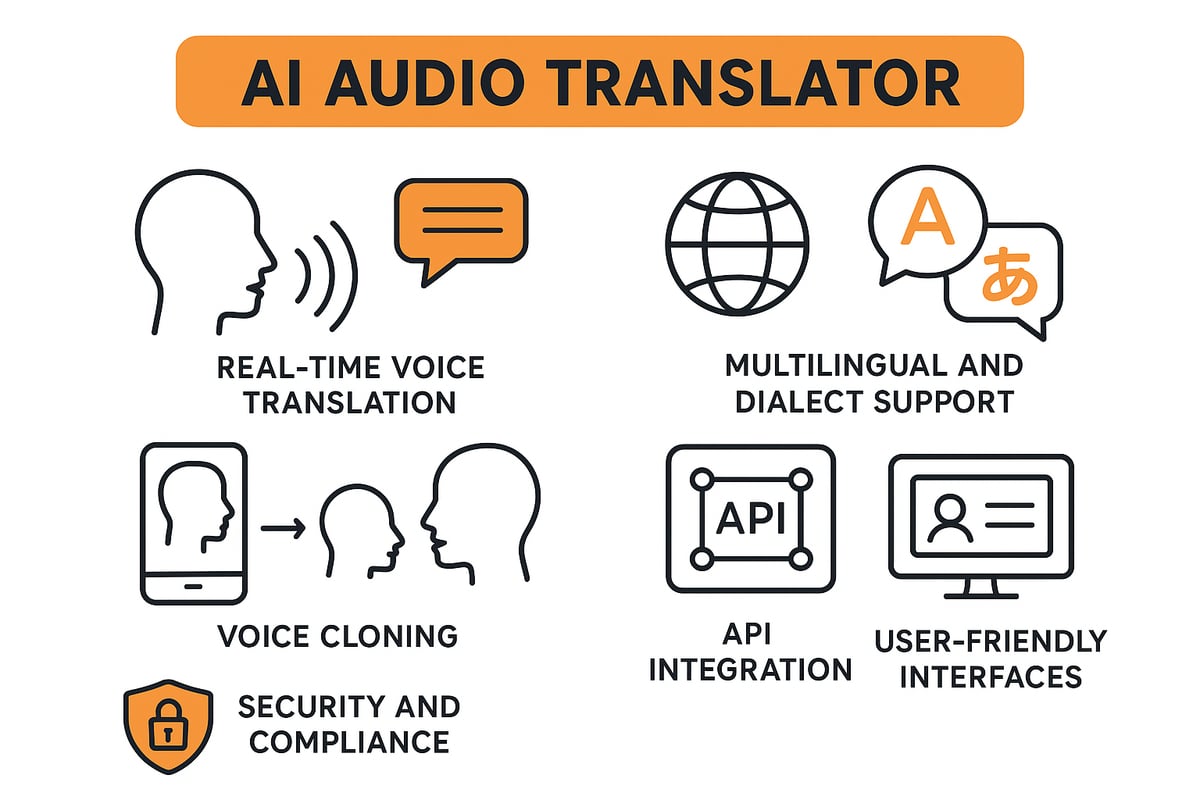
Real-Time Voice Translation
One of the standout attributes of an ai audio translator is real-time voice translation. This feature enables users to converse across languages instantly, whether in meetings, calls, or live events. The system listens, processes, and delivers spoken translations within seconds, making communication frictionless.
- Supports travel, business, healthcare, and customer support.
- Example: Maestra’s system identifies languages in under two seconds.
- Reduces waiting and response times in critical situations.
Recent AI advancements, such as those highlighted in Five AI Advancements Shaping the Language Industry in 2024, are making real-time translation more accurate, context-aware, and responsive than ever before. This progress is crucial for applications where every second counts.
Multilingual and Dialect Support
A robust ai audio translator must accommodate a vast range of languages and dialects. Leading platforms now support 125 to over 185 languages, including regional accents and less commonly spoken tongues.
- Essential for global accessibility and inclusion.
- Rask AI and Maestra both offer extensive language portfolios.
- Ensures users can interact confidently, no matter where they are.
Comprehensive dialect support closes communication gaps and fosters inclusivity. The ai audio translator empowers organizations to reach wider audiences and serve diverse communities.
Voice Cloning and Natural Speech Output
Voice cloning is a transformative feature in the ai audio translator landscape. This technology recreates the original speaker’s tone, style, and emotion, resulting in translations that sound natural and authentic.
- Ideal for content creators, educators, and media professionals.
- Preserves speaker intent and emotional nuance.
- Example: Maestra’s voice cloning for realistic dubbing.
By mimicking the original voice, the ai audio translator ensures that translated content remains engaging and relatable for listeners.
Seamless Integration and API Access
Flexibility is a hallmark of modern ai audio translator tools. Seamless integration with platforms such as Zoom, Teams, and call center applications streamlines workflows and enhances productivity.
- Developer APIs enable custom automation and unique translation workflows.
- Both Maestra and Rask AI offer detailed API documentation.
- Enterprises can embed translation directly into existing systems.
This level of integration allows the ai audio translator to adapt to industry-specific needs, from live event streaming to automated customer interactions.
Security, Privacy, and Compliance
Security is paramount for any ai audio translator, especially when handling sensitive conversations. Top solutions use encryption and strict data handling protocols to protect user privacy.
- Compliance with GDPR, HIPAA, and other industry standards.
- Essential for legal, healthcare, and emergency services.
- Regular audits and access controls safeguard confidential information.
Choosing an ai audio translator with robust compliance features ensures peace of mind and regulatory alignment.
User Experience and Accessibility
User experience is central to the effectiveness of an ai audio translator. Intuitive interfaces, mobile and web access, and customizable settings make these tools accessible to all users.
- Features like instant playback, subtitle export, and broad file compatibility.
- Support for different user roles and permissions.
- Streamlined onboarding and clear navigation.
By prioritizing usability, the ai audio translator removes barriers and encourages widespread adoption, making multilingual communication effortless.
Top Use Cases for Seamless Voice Translation
Imagine a world where language is no longer a barrier in any setting. The ai audio translator is now at the forefront of this transformation, enabling real-time, accurate communication across industries. Let’s explore the most impactful use cases shaping 2025.
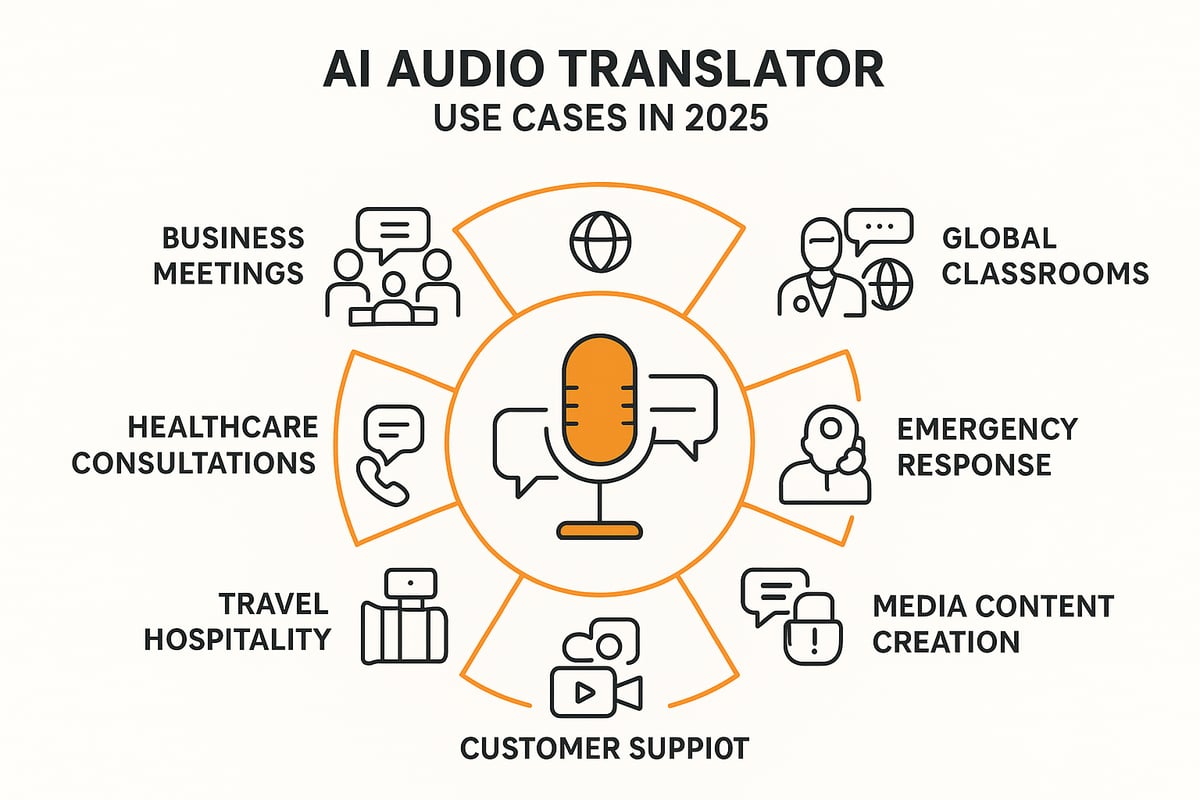
Business and Global Collaboration
Global enterprises rely on seamless communication to drive innovation. The ai audio translator empowers multinational teams to collaborate without language friction. During international meetings, participants can converse in their native languages and receive instant translations.
- Accelerates decision-making in cross-border projects.
- Supports remote work with multilingual teams.
- Enables campaign localization for marketing departments.
International marketing teams now use ai audio translator platforms to localize campaigns for diverse audiences, fostering a unified brand voice worldwide.
Education and E-Learning
Education is rapidly evolving with digital classrooms and global student bodies. The ai audio translator offers real-time translation for lectures, webinars, and online courses, making learning accessible to all.
- Bridges language gaps for non-native students.
- Facilitates global classroom participation.
- Supports universities in streaming multilingual lectures.
Universities are deploying ai audio translator solutions to ensure every student, regardless of language, can engage fully in academic content and discussions.
Healthcare and Patient Communication
Clear communication in healthcare is vital. The ai audio translator enables doctors and patients to interact effectively, regardless of native language, improving care quality and patient safety.
- Supports telemedicine consultations across languages.
- Reduces miscommunication in medical settings.
- Enhances accessibility for diverse patient populations.
Recent studies show that using an ai audio translator in healthcare leads to better patient outcomes and increased trust between providers and patients. For further insights, see how clinics are breaking language barriers in healthcare using AI-powered translation tools.
Emergency Services and Public Safety
During emergencies, every second counts. Emergency centers are leveraging ai audio translator technology for instant multilingual communication, ensuring critical information is conveyed swiftly and accurately.
- Assists 911 centers and first responders in diverse communities.
- Reduces response times for non-native speakers.
- Increases safety for both responders and citizens.
Platforms such as Convey911 deliver real-time translation for over 185 languages, unifying communication in high-pressure scenarios. Learn more about real-time AI emergency translation.
Media, Content Creation, and Entertainment
Content creators are expanding their global reach with ai audio translator solutions. These tools enable seamless dubbing, subtitling, and localization of podcasts, videos, and live streams.
- Automates translation for media assets.
- Makes content accessible in multiple languages.
- Supports creators in growing international audiences.
With support for over 125 languages, the ai audio translator transforms how creators connect with viewers worldwide, making entertainment more inclusive than ever.
Travel, Hospitality, and Tourism
The travel industry thrives on excellent service. The ai audio translator allows frontline staff to communicate with guests from any country, enhancing the guest experience and safety.
- Streamlines check-in and concierge services.
- Assists travelers with local navigation and emergencies.
- Improves guest satisfaction and loyalty.
Hotels and airlines now integrate ai audio translator tools to break down language barriers, ensuring every traveler feels welcome and understood.
Customer Support and Call Centers
Customer support is a critical touchpoint for any business. The ai audio translator provides multilingual support in real time, reducing wait times and improving satisfaction.
- Enables support desks to serve global customers efficiently.
- Increases first-call resolution rates.
- Enhances brand reputation for inclusivity.
Data shows that companies using ai audio translator technology achieve up to 30 percent faster issue resolution, setting a new standard for customer care.
| Use Case | Key Benefit | Typical Users |
|---|---|---|
| Business Collaboration | Real-time multilingual meetings | Enterprises, remote teams |
| Education & E-Learning | Inclusive global classrooms | Universities, online schools |
| Healthcare | Improved patient communication | Hospitals, clinics |
| Emergency Services | Faster, safer responses | 911 centers, first responders |
| Media & Entertainment | Global content reach | Creators, studios |
| Travel & Hospitality | Enhanced guest experience | Hotels, airlines |
| Customer Support | Multilingual, efficient service | Call centers, businesses |
The ai audio translator is unlocking new possibilities across every sector, making seamless voice translation a reality in 2025.
Step-by-Step Guide: Setting Up and Using an AI Audio Translator
Embarking on your journey with an AI audio translator involves more than downloading an app. Success hinges on clear needs assessment, careful platform selection, seamless integration, and ongoing compliance. This step-by-step guide walks you through the process, ensuring you unlock the full potential of AI-powered voice translation in your environment.
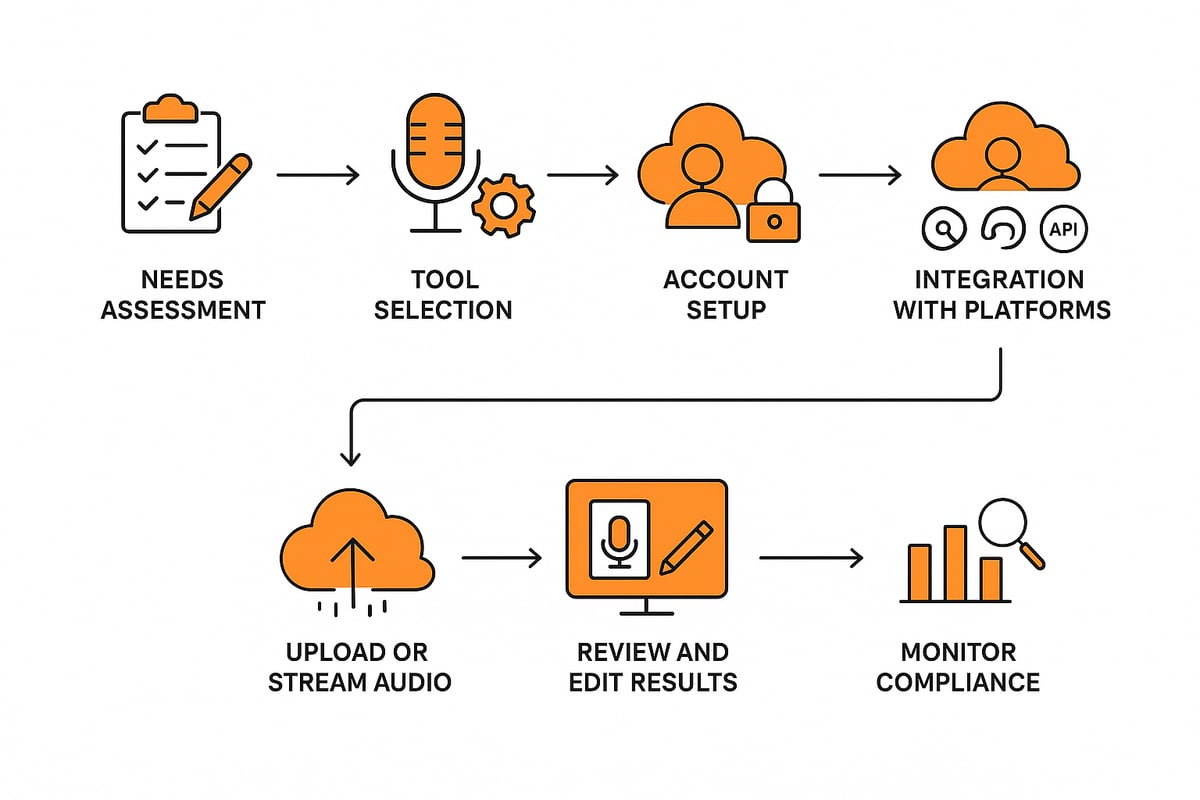
Step 1: Identify Your Translation Needs
Start by mapping your specific requirements for an AI audio translator. Determine which languages and dialects are essential for your audience or business operations. Evaluate the expected volume of translation—do you need real-time conversation support or batch processing for pre-recorded files? Consider whether your industry, such as healthcare, legal, or education, has unique compliance or integration needs. List the platforms you currently use, like CRM systems or communication tools, and note if API connectivity is required. By clarifying these points, you set the foundation for choosing a solution that fits your workflow and delivers measurable value.
Step 2: Choose the Right AI Audio Translator
Next, compare leading platforms to find the best AI audio translator for your use case. Review features such as supported languages, dialects, voice cloning, and real-time capabilities. Examine security credentials and regulatory compliance, especially if you handle sensitive data. Consider pricing structures, available user testimonials, and case studies. For enterprise needs, prioritize platforms that offer robust developer APIs and integration support. Create a checklist of must-have features and match them to shortlisted tools. This careful evaluation ensures you select a translator that aligns with your goals and technical environment.
Step 3: Account Setup and Configuration
Once you have chosen your AI audio translator, register for an account and select the appropriate plan. Many providers offer free trials, enterprise subscriptions, or API tiers. Customize your language preferences and choose output formats such as transcripts, subtitles, or dubbed audio. Set up user roles and permissions to maintain security and workflow efficiency. Most platforms provide guided onboarding and documentation to streamline setup. A well-configured account ensures smooth operation and maximizes the benefits of advanced translation technology from the start.
Step 4: Integrate with Your Workflow
Connect your AI audio translator to the platforms where you need seamless voice translation. Common integrations include video conferencing tools (Zoom, Teams), call center software, and websites. Use available APIs for automation or custom applications. For example, integrating your translator with Zoom enables live multilingual meetings. Review platform documentation for step-by-step instructions and best practices. Prioritize integrations that will save time, reduce manual effort, and allow for real-time or automated translation at critical touchpoints in your operations.
Step 5: Upload or Stream Audio for Translation
Prepare to use your AI audio translator by uploading files or streaming live audio. Supported formats typically include MP3, MP4, WAV, and live streams. Decide between batch translation for pre-recorded content or live conversation modes for instant translation. To optimize results, ensure your microphone setup is high quality and minimize background noise. Use the following checklist for better outcomes:
- Test audio quality before uploading
- Trim unnecessary silence or noise
- Choose the correct input language and dialect These practices help achieve accurate, natural-sounding translations every time.
Step 6: Review, Edit, and Export Results
After translation, use your AI audio translator’s interface to review transcripts and voice outputs. Check for accuracy, especially with technical terms or cultural nuances. Most platforms allow you to edit transcripts directly or adjust voice settings for better clarity. Once satisfied, export results in your preferred format, such as subtitles, full transcripts, or dubbed audio/video files. This flexibility supports a wide range of use cases, from media localization to accessible communications. Regular review ensures that your content meets both quality standards and audience expectations.
Step 7: Monitor Performance and Ensure Compliance
Continually monitor the performance of your AI audio translator to maintain high translation accuracy and fast turnaround times. Leverage built-in analytics and reporting features to track usage, identify bottlenecks, and improve workflows. For conversations involving sensitive information, confirm that your processes align with privacy laws and industry regulations. In mission-critical scenarios, consider hybrid models that combine AI with human oversight. To learn more about how AI and human interpreters collaborate in public safety, see AI-human interpreters in 911 communication. Ongoing vigilance ensures your translation solution remains secure, effective, and compliant.
Leading AI Audio Translator Tools in 2025
Choosing the right ai audio translator in 2025 means considering not just language support but also integration, accuracy, and security. A range of advanced tools now cater to diverse needs, from global enterprises to emergency services and content creators. Below, explore the leading solutions shaping seamless voice translation.
Maestra
Maestra stands out as a cloud-based ai audio translator designed for rapid, accurate voice and video translation. Supporting over 185 languages and dialects, it enables real-time conversion for meetings, content localization, and more. Its voice cloning feature mimics the original speaker’s tone and emotion, ensuring natural-sounding results.
With enterprise-grade security, Maestra offers seamless integration through APIs, making it suitable for businesses, educators, and content creators. The platform boasts over 800 unique voices, allowing for customization in dubbing and subtitling workflows.
Rask AI
Rask AI is another leading ai audio translator, emphasizing flexibility and accessibility. Its suite of free and premium tools covers transcription, dubbing, and subtitle generation across a vast array of languages and dialects. Rask AI’s real-time capabilities make it a favorite for marketing teams, e-learning providers, and global enterprises.
The platform’s intuitive interface, combined with robust API access, supports automated workflows and integration with popular platforms. Rask AI’s continuous updates ensure support for emerging dialects and industry-specific terms.
Google Translate & Microsoft Azure Speech
Both Google Translate and Microsoft Azure Speech remain foundational ai audio translator solutions, processing billions of translations daily. Their real-time voice translation features, mobile apps, and extensive API documentation make them accessible to individuals and organizations worldwide.
These platforms have expanded their language coverage, including support for indigenous and minority languages, as seen in initiatives like Adi Vaani: AI-Powered Translator for Tribal Languages. Their scalability and reliability make them indispensable for travel, customer support, and education.
Industry-Specific Solutions
Specialized ai audio translator tools have emerged for high-stakes environments. Convey911, for example, delivers patented AI-driven translation for first responders and public safety agencies. With support for over 185 languages and robust compliance, these platforms are transforming emergency communications.
In campus safety, multilingual solutions for campus safety demonstrate how real-time translation bridges communication gaps, ensuring timely and effective response in critical situations. Healthcare-focused translators, compliant with HIPAA, enable secure patient consultations across language barriers.
Comparison Table
Below is a feature-by-feature comparison of top ai audio translator platforms:
| Tool | Languages/Dialects | Real-Time Translation | Voice Cloning | API Integration | Security/Compliance | Use Cases |
|---|---|---|---|---|---|---|
| Maestra | 185+ | Yes | Yes | Yes | GDPR, HIPAA | Content, business, media |
| Rask AI | 125+ | Yes | Yes | Yes | GDPR | Marketing, e-learning |
| Google Translate | 100+ | Yes | No | Yes | Standard | Travel, education |
| Azure Speech | 100+ | Yes | No | Yes | HIPAA, GDPR | Enterprise, healthcare |
| Convey911 | 185+ | Yes | No | Yes | Public safety | Emergency, campus safety |
Selecting the best ai audio translator requires balancing language support, integration, and compliance with your specific needs. Whether for global business, emergency response, or inclusive education, these solutions offer a pathway to seamless multilingual communication.
The Future of AI Audio Translation: Trends and Innovations
As we look to the future, the ai audio translator is set to redefine how people connect and collaborate worldwide. The pace of innovation is accelerating, with new features and capabilities extending the reach and accuracy of real-time voice translation. Below, we explore the most important trends and breakthroughs shaping the next generation of ai audio translator technology.
Hyper-Realistic Voice Synthesis
Hyper-realistic voice synthesis is rapidly making the ai audio translator sound more like a natural human speaker. Recent advancements in neural networks allow for precise replication of emotional tone, accent, and even individual speaker characteristics. This technology is key for creating authentic, accessible content in multiple languages.
Cutting-edge models like Hibiki are pushing boundaries in simultaneous speech-to-speech translation, tackling the persistent challenge of real-time interpretation without sacrificing fidelity. For a deeper dive into these breakthroughs, see the High-Fidelity Simultaneous Speech-To-Speech Translation study. With these improvements, ai audio translator tools can deliver translations that feel genuine, bridging cultural gaps and making content globally relevant.
Ubiquitous Multilingual Communication
The ai audio translator is becoming a seamless part of everyday life, embedded in smartphones, wearables, and smart home devices. This ubiquity means users can access instant translation in any setting, whether attending multilingual meetings, traveling abroad, or participating in international events.
Real-time group translation is now possible, allowing multiple speakers to communicate effortlessly across languages. As integration with IoT expands, expect ai audio translator solutions to support voice-driven interactions in cars, appliances, and public spaces, making multilingual communication truly universal.
Cross-Platform and Industry Integration
Future ai audio translator solutions will offer deeper integration with business and industry platforms. Seamless connections with CRM, ERP, telehealth, and emergency systems will enable organizations to break language barriers across every touchpoint.
For example, 911 centers are already embedding ai audio translator technology for instant language support, improving response times and accessibility. This trend will continue, empowering sectors like healthcare, finance, and customer service to deliver multilingual support at scale and with minimal friction.
AI-Human Hybrid Translation Models
While ai audio translator models are advancing rapidly, high-stakes scenarios still benefit from human oversight. Hybrid translation models combine the speed of AI with the nuance and contextual understanding of human experts.
This approach is especially valuable in legal, medical, and public safety settings where accuracy is crucial. AI provides the initial translation, while professionals review and refine output to ensure clarity and compliance. This balance will remain essential as ai audio translator tools evolve.
Data Privacy, Ethics, and Regulation
As ai audio translator usage grows, so do concerns about data privacy and ethical standards. Stricter regulations are emerging to govern how voice data is collected, processed, and stored. Compliance with GDPR, HIPAA, and similar frameworks is now a baseline requirement.
Additionally, the industry is addressing ethical challenges like deepfake prevention and responsible voice synthesis. Developers of ai audio translator platforms are investing in transparent data practices and robust security to maintain trust and protect sensitive communications.
Democratization and Accessibility
The democratization of ai audio translator tools is opening doors for individuals, small businesses, and non-profits. Free and low-cost options are expanding, making advanced translation capabilities accessible to a wider audience.
Support for minority languages and regional dialects is also increasing, driven by larger and more diverse training datasets. This trend ensures that global communication remains inclusive, allowing more voices to participate and be understood.
Statistics and Industry Projections
The ai audio translator market is experiencing exponential growth. Industry projections estimate the market will surpass $25 billion by 2025, reflecting widespread adoption across sectors.
| Metric | 2025 Projection |
|---|---|
| Market Value | $25B+ |
| Enterprise Adoption Rate | 60%+ |
| Supported Languages/Dialects | 185+ |
| Real-Time Streaming Availability | Global standard |
Major platforms like Maestra and Rask AI are expanding their reach, supporting over 185 languages and enabling real-time streaming for global users. The future of ai audio translator technology is set to transform how we understand and interact with the world.
As you’ve seen throughout this guide, the future of AI audio translation is all about instant, accurate communication—especially when every second counts. If you want to experience how seamless voice translation can break down barriers in real-world emergencies and public safety, why not see it in action? You can explore how Convey911’s technology empowers 911 centers and first responders to deliver life saving assistance faster, with clear communication in over 185 languages. Ready to discover firsthand how AI can transform your team’s response? Book a Demo and take the next step toward seamless multilingual communication.


